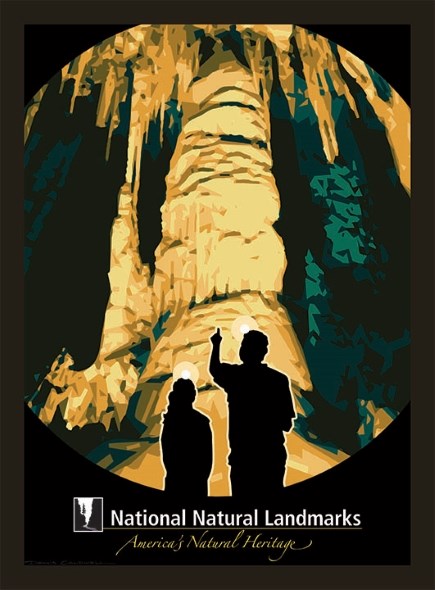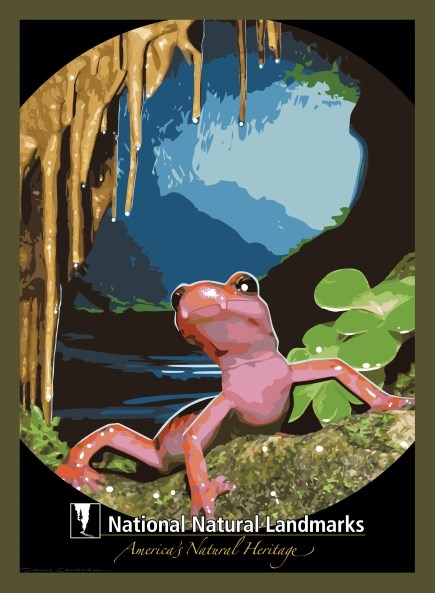
Characterized by a natural opening in the ground extending beyond the zone of light, caves occur in a wide variety of rock types. They can range in size from single, small rooms to interconnecting passages many miles long. Solution caves are the most common and well-known type of cave; others include lava, sea, and glacier caves. Spelothems, or cave formations, such as stalactites, stalagmites, columns, and drapery are mineral deposits that decorate the interior of most caves.
From limestone caverns to volcanic lava tubes, there are national natural landmarks designated for their outstanding illustration of the different types of caves. Some of these include:
- Shelta Cave, AL
- Cathedral Caverns, AL
- Black Chasm Cave, CA
- Lake Shasta Caverns, CA
- Mitchell Caverns & Winding Stair Cave, CA
- Florida Caverns Natural Area, FL
- Donaldson Cave System & Woods Site, IN
- Marengo Cave, IN
- Wyandotte Cave, IN
- Marvel Cave, MO
- Cumberland Caverns, TN
- Lost Sea (Craighead Caverns), TN
- Cave Without a Name, TX
- Caverns of Sonora, TX
- Natural Bridge Caverns, TX
- Butler Cave - Breathing Cave, VA
- Grand Caverns, VA
- Luray Caverns, VA
- Organ Cave System, WV
- Lost World Caverns, WV
- Cave of the Mounds, WI

Cave Ecology
Caves are unique ecosystems that support a variety of specialized species and offer insights into the complex relationships between organisms and their environments. These subterranean habitats are home to life adapted to extreme conditions.
Cave ecosystems are divided into several zones. The entrance zone, exposed to some light, hosts plants, bats, amphibians, and small mammals. The twilight zone has low illumination and supports species like fungi, invertebrates, and bats. The dark zone, devoid of natural light, is home to troglobites, such as blind crayfish and cave beetles, relying on organic material or minerals for food. Below this, the phreatic zone contains submerged water and species adapted to nutrient-poor conditions, like aquatic invertebrates and cave fish.
These specialized ecosystems are shaped by factors such as temperature, humidity, and food availability, and provide critical insights into evolutionary adaptations, emphasizing the importance of cave conservation.
There are national natural landmarks designated for their outstanding illustration of cave ecology. Some of these include:

Photo by Peter Jones
2021 International Year of Caves and Karst
In 2021 the NNL Program joined the celebration of cave and karst resources through the International Year of Caves and Karst (IYCK). In addition to learning about some of the NNL caves listed above, we encourage you to explore the links below for more information about events and activities associated with IYCK.
-
Become a Junior Cave Scientist
-
Join the NPS in celebrating these important resources
-
Learn about and join events world-wide
- View the cave art contest submissions and winners
Discover more about caves and National Natural Landmarks
Last updated: April 10, 2025
